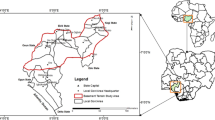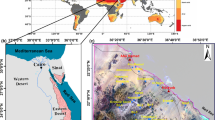Abstract
Exploring for groundwater in crystalline rocks in semiarid areas is a challenge because of their complex hydrogeology and low potential yields. An integrated approach was applied in central western Mozambique, in an area covered by Precambrian crystalline basement rocks. The approach combined a digital elevation model (DEM), remote sensing, and a ground-based geophysical survey. The aim was to identify groundwater zones with high potential and to identify geological structures controlling that potential. Lineaments were extracted from the DEM that had been enhanced using an adaptive-tilt, multi-directional, shading technique and a non-filtering technique to characterize the regional fracture system. The shallowness and amount of stored groundwater in the fracture zones was assessed using vegetation indices derived from Landsat 8 OLI images. Then, 14 transient electromagnetic (TEM) survey profiles were taken in different geological settings across continuous lineaments that were considered to be aligned along inferred faults. In the central lineament zones, the TEM soundings gave resistivity values of less than 300 Ωm at a depth of 20–80 m. The values varied with location. Conversely, values greater than 400 Ωm were observed at the sites away from the central zones. This contrast is probably caused by the differences in permeability and degree of weathering along the fractured zones. These differences could be key factors in determining groundwater occurrence. By integrating five water-related factors (lineament density, slope, geology, vegetation index, and proximity to lineaments), high groundwater potential zones were located in the vicinity of the lineaments. In these zones, vegetation remains active regardless of the season.


















Similar content being viewed by others
References
Abdalla, F. (2012). Mapping of groundwater prospective zones using remote sensing and GIS techniques: A case study from the Central Eastern Desert, Egypt. Journal of African Earth Sciences, 70, 8–17. https://doi.org/10.1016/j.jafrearsci.2012.05.003.
Acworth, R. I. (1987). The development of crystalline basement aquifers in a tropical environment. Quarterly Journal of Engineering Geology and Hydrogeology, 20(4), 265–272. https://doi.org/10.1144/GSL.QJEG.1987.020.04.02.
Archie, G. E. (1942). The electrical resistivity log as an aid in determining some reservoir characteristics. Transactions of the AIME, 146(1), 54–62. https://doi.org/10.2118/942054-G.
Árnason, K. (1989). Central loop transient electromagnetic soundings over a horizontally layered earth. Reykjavik: OS-89032/JHD-06.
Auken, E., Pellerin, L., Christensen, N. B., & Sørensen, K. (2006). A survey of current trends in near-surface electrical and electromagnetic methods. Geophysics, 71(5), G249–G260. https://doi.org/10.1190/1.2335575.
Barsukov, P. O., Fainberg, E. B., & Khabensky, E. O. (2006). Shallow investigations by TEM-FAST technique: methodology and examples. Methods in Geochemistry and Geophysics, 40, 55–77. https://doi.org/10.1016/S0076-6895(06)40003-2.
Bense, V. F., Gleeson, T., Loveless, S. E., Bour, O., & Scibek, J. (2013). Fault zone hydrogeology. Earth-Science Reviews, 127, 171–192. https://doi.org/10.1016/j.earscirev.2013.09.008.
Bicca, M. M., Philipp, R. P., Jelinek, A. R., Ketzer, J. M. M., dos Santos Scherer, C. M., Jamal, D. L., et al. (2017). Permian-Early Triassic tectonics and stratigraphy of the Karoo Supergroup in northwestern Mozambique. Journal of African Earth Sciences, 130, 8–27. https://doi.org/10.1016/j.jafrearsci.2017.03.003.
Brunner, P., Hendricks Franssen, H.-J., Kgotlhang, L., Bauer-Gottwein, P., & Kinzelbach, W. (2007). How can remote sensing contribute in groundwater modeling? Hydrogeology Journal, 15(1), 5–18. https://doi.org/10.1007/s10040-006-0127-z.
CGS. (2007). Map Explanation: Sheets Furancungo (1433) and Ulongue (1434), Scale 1:250000. Maputo: Ministério dos Recursos Minerais, Direcção Nacional de Geologia.
Chilton, P. J., & Foster, S. S. D. (1995). Hydrogeological characterisation and water-supply potential of basement aquifers in Tropical Africa. Hydrogeology Journal, 3(1), 36–49. https://doi.org/10.1007/s100400050061.
Chongo, M., Vest Christiansen, A., Tembo, A., Banda, K. E., Nyambe, I. A., Larsen, F., et al. (2015). Airborne and ground-based transient electromagnetic mapping of groundwater salinity in the Machile-Zambezi Basin, southwestern Zambia. Near Surface Geophysics, 13, 383–395. https://doi.org/10.3997/1873-0604.2015024.
Civco, D. L. (1989). Topographic normalization of Landsat Thematic Mapper digital imagery. Photogrammetric Engineering and Remote Sensing, 55(9), 1303–1309.
Costabel, S., Siemon, B., Houben, G., & Günther, T. (2017). Geophysical investigation of a freshwater lens on the island of Langeoog, Germany—Insights from combined HEM, TEM and MRS data. Journal of Applied Geophysics, 136, 231–245. https://doi.org/10.1016/j.jappgeo.2016.11.007.
Danielsen, J. E., Auken, E., Jørgensen, F., Søndergaard, V., & Sørensen, K. I. (2003). The application of the transient electromagnetic method in hydrogeophysical surveys. Journal of Applied Geophysics, 53(4), 181–198. https://doi.org/10.1016/j.jappgeo.2003.08.004.
Danielsen, J. E., Dahlin, T., Owen, R., Mangeya, P., & Auken, E. (2007). Geophysical and hydrogeologic investigation of groundwater in the Karoo stratigraphic sequence at Sawmills in northern Matabeleland, Zimbabwe: A case history. Hydrogeology Journal, 15(5), 945–960. https://doi.org/10.1007/s10040-007-0191-z.
DNA. (1987). Carta Hidrogeológica escala 1:1000000, 1 a edição. Maputo: Ministério de Construção e Águas, Direcção Nacional de Águas.
DNG. (2006). Geological sheet 1:250000, No. 1434. Maputo: Ministério dos Recursos Minerais, Direcção Nacional de Geologia.
Fitterman, D. V., & Stewart, M. T. (1986). Transient electromagnetic sounding for groundwater. Geophysics, 51(4), 995–1005.
Fox, D. M., Bryan, R. B., & Price, A. G. (1997). The influence of slope angle on final infiltration rate for interrill conditions. Geoderma, 80(1–2), 181–194. https://doi.org/10.1016/S0016-7061(97)00075-X.
Henebry, G. M. (1993). Detecting change in grasslands using measures of spatial dependence with landsat TM data. Remote Sensing of Environment, 46(2), 223–234. https://doi.org/10.1016/0034-4257(93)90097-H.
Jarvis, A., Reuter, H. I., Nelson, A., & Guevara, E. (2008). Hole-filled SRTM for the globe Version 4, available from the CGIAR-CSI SRTM 90m Database. http://srtm.csi.cgiar.org. Accessed 11 Sep 2015.
Koike, K., Nagano, S., & Kawaba, K. (1998). Construction and analysis of interpreted fracture planes through combination of satellite-image derived lineaments and digital elevation model data. Computers & Geosciences, 24(6), 573–583. https://doi.org/10.1016/S0098-3004(98)00021-1.
Koike, K., Nagano, S., & Ohmi, M. (1995). Lineament analysis of satellite images using a Segment Tracing Algorithm (STA). Computers & Geosciences, 21(9), 1091–1104. https://doi.org/10.1016/0098-3004(95)00042-7.
Krishnamurthy, J., Venkatesa Kumar, N., Jayaraman, V., & Manivel, M. (1996). An approach to demarcate ground water potential zones through remote sensing and a geographical information system. International Journal of Remote Sensing, 17(10), 1867–1884. https://doi.org/10.1080/01431169608948744.
Lächelt, S. (2004). Geology and mineral resources of Mozambique. Maputo: Ministério dos Recursos Minerais e Energia, Direcção Nacional de Geologia.
Mallast, U., Gloaguen, R., Geyer, S., Rödiger, T., & Siebert, C. (2011). Derivation of groundwater flow-paths based on semi-automatic extraction of lineaments from remote sensing data. Hydrology and Earth System Sciences, 15(8), 2665–2678. https://doi.org/10.5194/hess-15-2665-2011.
Martínez-Moreno, F. J., Monteiro-Santos, F. A., Madeira, J., Bernardo, I., Soares, A., Esteves, M., et al. (2016). Water prospection in volcanic islands by Time Domain Electromagnetic (TDEM) surveying: The case study of the islands of Fogo and Santo Antão in Cape Verde. Journal of Applied Geophysics, 134, 226–234. https://doi.org/10.1016/j.jappgeo.2016.09.020.
Masoud, A., & Koike, K. (2006). Tectonic architecture through Landsat-7 ETM+/SRTM DEM-derived lineaments and relationship to the hydrogeologic setting in Siwa region, NW Egypt. Journal of African Earth Sciences, 45(4–5), 467–477. https://doi.org/10.1016/j.jafrearsci.2006.04.005.
Masoud, A., & Koike, K. (2011a). Auto-detection and integration of tectonically significant lineaments from SRTM DEM and remotely-sensed geophysical data. ISPRS Journal of Photogrammetry and Remote Sensing, 66(6), 818–832. https://doi.org/10.1016/j.isprsjprs.2011.08.003.
Masoud, A., & Koike, K. (2011b). Morphotectonics inferred from the analysis of topographic lineaments auto-detected from DEMs: Application and validation for the Sinai Peninsula, Egypt. Tectonophysics, 510(3), 291–308. https://doi.org/10.1016/j.tecto.2011.07.010.
Masoud, A., & Koike, K. (2017). Applicability of computer-aided comprehensive tool (LINDA: LINeament Detection and Analysis) and shaded digital elevation model for characterizing and interpreting morphotectonic features from lineaments. Computers & Geosciences, 106, 89–100. https://doi.org/10.1016/j.cageo.2017.06.006.
Matthew, M. W., Adler-Golden, M. S. M., Berk, A., Richtsmeier, S. C., Levine, R. Y., Bernstein, L. S., et al. (2000). Status of atmospheric correction using a MODTRAN4-based algorithm. In S. S. Chen & M. R. Descour (Eds.), Algorithms for multispectral, hyperspectral, and ultraspectral imagery VI, proceedings of SPIE (Vol. 4049, p. 207).
Nabighian, M. N. (Ed.). (1991). Electromagnetic methods in applied geophysics. Society of Exploration Geophysicists. https://doi.org/10.1190/1.9781560802686.
National Research Council. (1996). Rock fractures and fluid flow: Contemporary understanding and applications. Washington, DC: The National Academies Press. https://doi.org/10.17226/2309.
Qi, J., Chehbouni, A., Huete, A. R., Kerr, Y. H., & Sorooshian, S. (1994). A modified soil adjusted vegetation index. Remote Sensing of Environment, 48(2), 119–126. https://doi.org/10.1016/0034-4257(94)90134-1.
Ranganai, R. T., & Ebinger, C. J. (2008). Aeromagnetic and Landsat TM structural interpretation for identifying regional groundwater exploration targets, south-central Zimbabwe Craton. Journal of Applied Geophysics, 65(2), 73–83. https://doi.org/10.1016/j.jappgeo.2008.05.009.
Reynolds, J. M. (2011). An introduction to applied and environmental geophysics. New York: Wiley-Blackwell.
Riaño, D., Chuvieco, E., Salas, J., & Aguado, I. (2003). Assessment of different topographic corrections in landsat-TM data for mapping vegetation types. IEEE Transactions on Geoscience and Remote Sensing, 41(5), 1056–1061. https://doi.org/10.1109/TGRS.2003.811693.
Rondeaux, G., Steven, M., & Baret, F. (1996). Optimization of soil-adjusted vegetation indices. Remote Sensing of Environment, 55(2), 95–107. https://doi.org/10.1016/0034-4257(95)00186-7.
Rouse, J. W., Haas, R. H., Schell, J. A., Deering, D. W., & Harlan, J. C. (1974). Monitoring the vernal advancement and retrogradation (green wave effect) of natural vegetation. Texas: NASA/GSFC, Type II, Progress Report.
Ruland, W. W., Cherry, J. A., & Feenstra, S. (1991). The depth of fractures and active ground-water flow in a clayey till plain in Southwestern Ontario. Ground Water, 29(3), 405–417. https://doi.org/10.1111/j.1745-6584.1991.tb00531.x.
Sander, P. (2007). Lineaments in groundwater exploration: A review of applications and limitations. Hydrogeology Journal, 15, 71–74. https://doi.org/10.1007/s10040-006-0138-9.
Sapia, V., Viezzoli, A., Jorgensen, F., Oldenborger, G. A., & Marchetti, M. (2014). The impact on geological and hydrogeological mapping results of moving from ground to airborne TEM. Journal of Environmental and Engineering Geophysics, 19(1), 53–66. https://doi.org/10.2113/JEEG19.1.53.
Saraf, A. K., & Choudhury, P. R. (1998). Integrated remote sensing and GIS for groundwater exploration and identification of artificial recharge sites. International Journal of Remote Sensing, 19(10), 1825–1841. https://doi.org/10.1080/014311698215018.
Shaban, A., Khawlie, M., & Abdallah, C. (2006). Use of remote sensing and GIS to determine recharge potential zones: The case of Occidental Lebanon. Hydrogeology Journal, 14(4), 433–443. https://doi.org/10.1007/s10040-005-0437-6.
Shahid, S., Nath, S. K., & Roy, J. (2000). Groundwater potential modelling in a soft rock area using a GIS. International Journal of Remote Sensing, 21(9), 1919–1924. https://doi.org/10.1080/014311600209823.
Teillet, P. M., Guindon, B., & Goodenough, D. G. (1982). On the slope-aspect correction of multispectral scanner data. Canadian Journal of Remote Sensing, 8, 84–106. https://doi.org/10.1080/07038992.1982.10855028.
Tessema, A., Mengistu, H., Chirenje, E., Abiye, T. A., & Demlie, M. B. (2012). The relationship between lineaments and borehole yield in North West Province, South Africa: results from geophysical studies. Hydrogeology Journal, 20(2), 351–368. https://doi.org/10.1007/s10040-011-0803-5.
Wang, L., Tian, B., Masoud, A., & Koike, K. (2013). Relationship between remotely sensed vegetation change and fracture zones induced by the 2008 Wenchuan earthquake, China. Journal of Earth Science, 24(2), 282–296. https://doi.org/10.1007/s12583-013-0329-y.
Wright, E. P. (1992). The hydrogeology of crystalline basement aquifers in Africa. Hydrogeology of Crystalline Basement Aquifers in Africa Geological Society Special Publication, 66, 1–27. https://doi.org/10.1144/GSL.SP.1992.066.01.01.
Acknowledgments
The authors would like to express their gratitude to the Japan International Cooperation Agency (JICA) for funding the field survey and supporting this research. We thank the Water and Sanitation Division (Direcção de Água e Saneamento) of Tete Province in Mozambique, for providing the wells data. Sincere thanks are extended to the two anonymous reviewers for their valuable comments and suggestions that helped improve the clarity of the manuscript.
Author information
Authors and Affiliations
Corresponding author
Rights and permissions
About this article
Cite this article
Magaia, L.A., Goto, Tn., Masoud, A.A. et al. Identifying Groundwater Potential in Crystalline Basement Rocks Using Remote Sensing and Electromagnetic Sounding Techniques in Central Western Mozambique. Nat Resour Res 27, 275–298 (2018). https://doi.org/10.1007/s11053-017-9360-5
Received:
Accepted:
Published:
Issue Date:
DOI: https://doi.org/10.1007/s11053-017-9360-5




